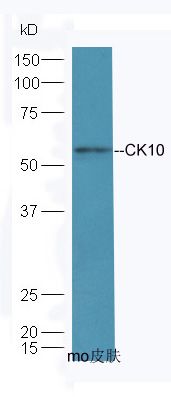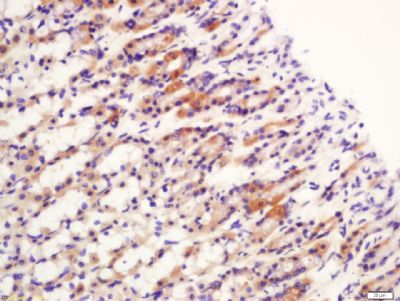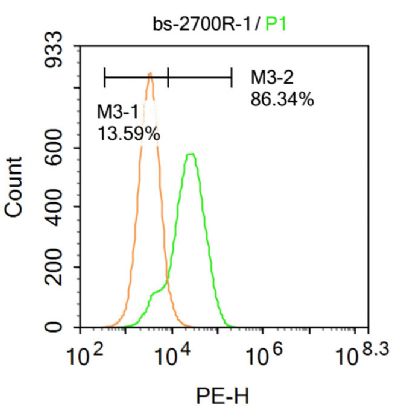产品中心
当前位置:首页>产品中心Anti-CK10
货号: bs-2700R 基本售价: 780.0 元 规格: 50ul
- 规格:50ul
- 价格:780.00元
- 规格:100ul
- 价格:1380.00元
- 规格:200ul
- 价格:2200.00元
产品信息
- 产品编号
- bs-2700R
- 英文名称
- CK10
- 中文名称
- 细胞角蛋白10抗体
- 别 名
- 56 kDa cytokeratin; BCIE; BIE; CK 10; CK-10; ck10; Cytokeratin 10; Cytokeratin 6B; Cytokeratin VIB; Cytokeratin-10; Cytokeratin10; EHK; k10; K1C10_HUMAN; Keratin 10; Keratin; Keratin type i cytoskeletal 10; Keratin type I cytoskeletal 59 kDa; Keratin-10; Keratin10; kpp; Krt 1 10; Krt 10; KRT10; krt10 ; type I cytoskeletal 10; Type I keratin Ka10; Keratin, type I cytoskeletal 10; Cytokeratin-10; K10.
- 规格价格
- 50ul/780元购买 100ul/1380元购买 200ul/2200元购买 大包装/询价
- 说 明 书
- 50ul 100ul 200ul
- 研究领域
- 肿瘤 细胞周期蛋白
- 抗体来源
- Rabbit
- 克隆类型
- Polyclonal
- 交叉反应
- Human, Mouse, Rat, Dog, Pig, Cow, Horse, Rabbit, Guinea Pig,
- 产品应用
- WB=1:500-2000 ELISA=1:500-1000 IHC-P=1:400-800 IHC-F=1:400-800 Flow-Cyt=1ug/Test IF=1:100-500 (石蜡切片需做抗原修复)
not yet tested in other applications.
optimal dilutions/concentrations should be determined by the end user.
- 分 子 量
- 56kDa
- 细胞定位
- 细胞核 细胞浆 细胞膜
- 性 状
- Lyophilized or Liquid
- 浓 度
- 1mg/ml
- 免 疫 原
- KLH conjugated synthetic peptide derived from human CK10:151-250/584
- 亚 型
- IgG
- 纯化方法
- affinity purified by Protein A
- 储 存 液
- 0.01M TBS(pH7.4) with 1% BSA, 0.03% Proclin300 and 50% Glycerol.
- 保存条件
- Store at -20 °C for one year. Avoid repeated freeze/thaw cycles. The lyophilized antibody is stable at room temperature for at least one month and for greater than a year when kept at -20°C. When reconstituted in sterile pH 7.4 0.01M PBS or diluent of antibody the antibody is stable for at least two weeks at 2-4 °C.
- PubMed
- PubMed
- 产品介绍
- background:
Cytokeratin 10 is a heterotetramer of two type I and two type II keratins. Cytokeratin 10 is generally associated with keratin 1. It is seen in all suprabasal cell layers including stratum corneum. A number of alleles are known that mainly differ in the Gly-rich region (positions 490-560). Defects in cytokeratin 10 are a cause of epidermolytic hyperkeratosis (EHK), also known as bullous congenital ichthyosiform erythroderma (BCIE) or bullous erythroderma ichthyosiformis congenita of Brocq. EHK is an hereditary skin disorder characterized by blistering and a marked thickening of the stratum corneum. At birth, affected individuals usually present with redness, blisters and superficial erosions due to cytolysis. Within a few weeks, the erythroderma and blister formation diminish and hyperkeratoses develop. Transmission is autosomal dominant, but most cases are sporadic. Defects in cytokeratin 10 are also a cause of annular epidermolytic ichthyosis (AEI), also known as cyclic ichthyosis with epidermolytic hyperkeratosis. AEI resembles clinical and histologic features of both epidermolytic hyperkeratosis and ichthyosis bullosa of Siemens.
Subunit:
Heterotetramer of two type I and two type II keratins. keratin-10 is generally associated with keratin-1.
Tissue Specificity:
Seen in all suprabasal cell layers including stratum corneum.
DISEASE:
Epidermolytic hyperkeratosis (EHK) [MIM:113800]: An autosomal dominant skin disorder characterized by widespread blistering and an ichthyotic erythroderma at birth that persist into adulthood. Histologically there is a diffuse epidermolytic degeneration in the lower spinous layer of the epidermis. Within a few weeks from birth, erythroderma and blister formation diminish and hyperkeratoses develop. Note=The disease is caused by mutations affecting the gene represented in this entry.
Ichthyosis annular epidermolytic (AEI) [MIM:607602]: A skin disorder resembling bullous congenital ichthyosiform erythroderma. Affected individuals present with bullous ichthyosis in early childhood and hyperkeratotic lichenified plaques in the flexural areas and extensor surfaces at later ages. The feature that distinguishes AEI from BCIE is dramatic episodes of flares of annular polycyclic plaques with scale, which coalesce to involve most of the body surface and can persist for several weeks or even months. Note=The disease is caused by mutations affecting the gene represented in this entry.
Erythroderma, ichthyosiform, congenital reticular (CRIE) [MIM:609165]: A rare skin condition characterized by slowly enlarging islands of normal skin surrounded by erythematous ichthyotic patches in a reticulated pattern. The condition starts in infancy as a lamellar ichthyosis, with small islands of normal skin resembling confetti appearing in late childhood and at puberty. Histopathologic findings include band-like parakeratosis, psoriasiform acanthosis, and vacuolization of keratinocytes with binucleated cells in the upper epidermis, sometimes associated with amyloid deposition in the dermis. Ultrastructural abnormalities include perinuclear shells formed from a network of fine filaments in the upper epidermis. Note=The disease is caused by mutations affecting the gene represented in this entry.
Similarity:
Belongs to the intermediate filament family.
SWISS:
P13645
Gene ID:
3858
Database links:Entrez Gene: 3858 Human
Entrez Gene: 16661 Mouse
Entrez Gene: 450225 Rat
Omim: 148080 Human
SwissProt: P13645 Human
SwissProt: P02535 Mouse
SwissProt: Q6IFW6 Rat
Unigene: 99936 Human
Unigene: 22662 Mouse
Unigene: 125065 Rat
Important Note:
This product as supplied is intended for research use only, not for use in human, therapeutic or diagnostic applications.
细胞角蛋白是形成上皮细胞细胞骨架中间纤维的一类结构相关蛋白。CK10属于I型角蛋白,常常与CK1一起存在。缺失CK10与表皮松解性角化症(EHK)以及表皮松解性鳞癣病(AEI)密切相关。主要标记上皮的基底上层和颗粒细胞层细胞,同时CK10表达与细胞的分化程度呈正比,高分化者常阳性更强,故常用于鳞状细胞癌的诊断。
- 产品图片
 Sample:Skin(Mouse) lysate at 30ug;
Sample:Skin(Mouse) lysate at 30ug;
Primary: Anti-CK10 (bs-2700R) at 1:300 dilution;
Secondary: HRP conjugated Goat-Anti-rabbit IgG(bs-0295G-HRP) at 1: 5000 dilution;
Predicted band size:56 kD
Observed band size:56 kD Tissue/cell: rat stomach tissue; 4% Paraformaldehyde-fixed and paraffin-embedded;
Tissue/cell: rat stomach tissue; 4% Paraformaldehyde-fixed and paraffin-embedded;
Antigen retrieval: citrate buffer ( 0.01M, pH 6.0 ), Boiling bathing for 15min; Block endogenous peroxidase by 3% Hydrogen peroxide for 30min; Blocking buffer (normal goat serum,C-0005) at 37℃ for 20 min;
Incubation: Anti-CK10 Polyclonal Antibody, Unconjugated(bs-2700R) 1:200, overnight at 4°C, followed by conjugation to the secondary antibody(SP-0023) and DAB(C-0010) staining Blank control: Hela.
Blank control: Hela.
Primary Antibody (green line): Rabbit Anti-CK10 antibody (bs-2700R)
Dilution: 1μg /10^6 cells;
Isotype Control Antibody (orange line): Rabbit IgG .
Secondary Antibody : Goat anti-rabbit IgG-PE
Dilution: 1μg /test.
Protocol
The cells were fixed with 4% PFA (10min at room temperature)and then permeabilized with 90% ice-cold methanol for 20 min at-20℃. The cells were then incubated in 5%BSA to block non-specific protein-protein interactions for 30 min at at room temperature .Cells stained with Primary Antibody for 30 min at room temperature. The secondary antibody used for 40 min at room temperature. Acquisition of 20,000 events was performed.

